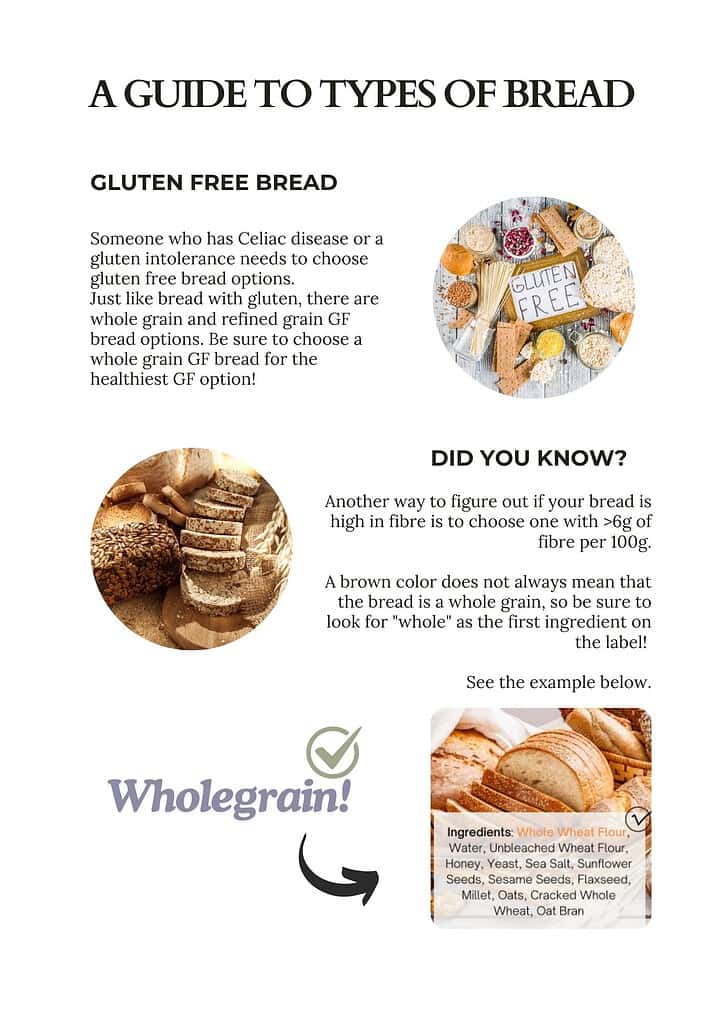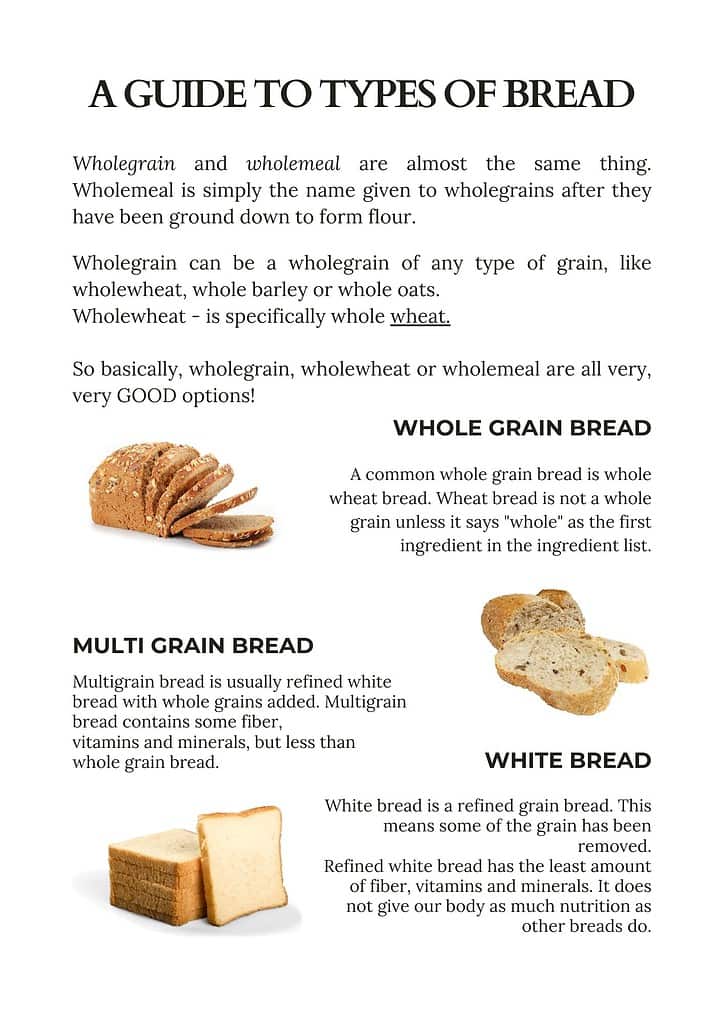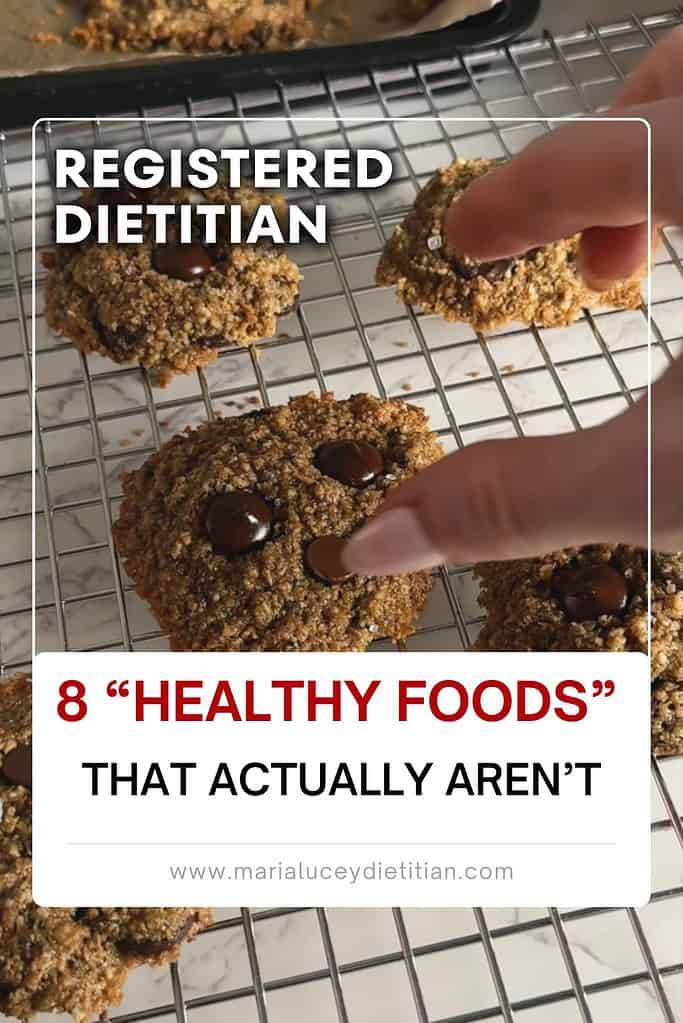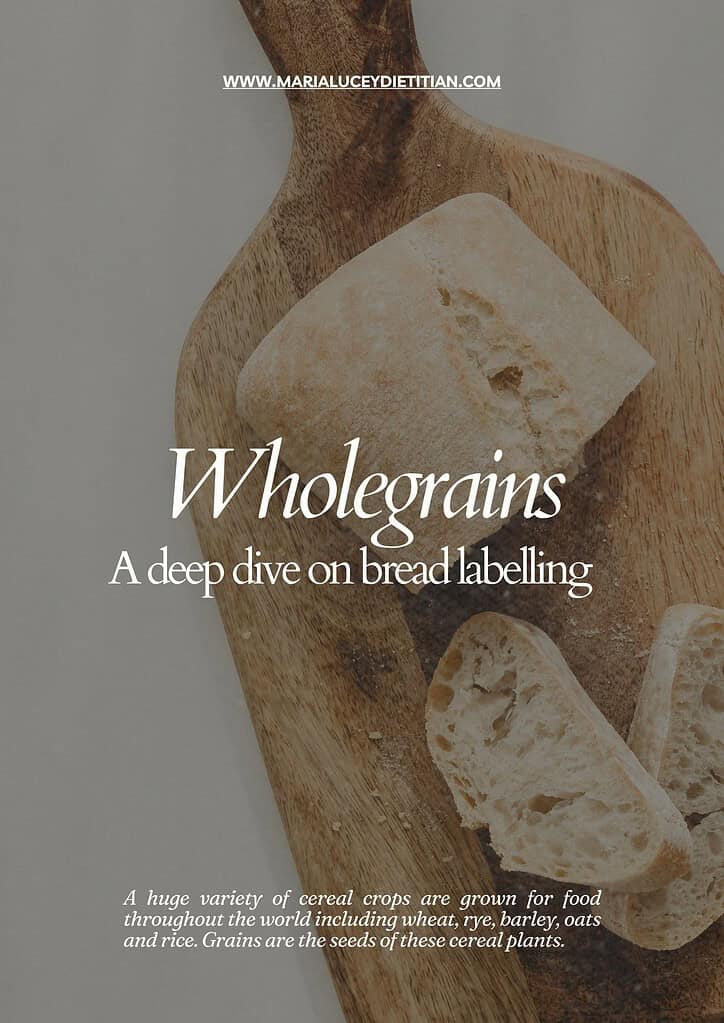Clever marketing campaigns often make us believe that certain foods are healthier for us than they actually are. And in our ongoing quest to become healthier versions of ourselves, we often spend a lot of money on these products. But is it all just a marketing ploy? Are some of these foods even making it harder to achieve our health goals?
Let's dive in and uncover the truth about some of these so-called "healthy" foods.
Now, I want to highlight that this is not a list of 8 foods you should never eat. My goal as a Registered Dietitian is simple: to help you as a consumer make a more informed choice. I’m not here to demonize certain foods, but I can provide tips to stop marketing companies from taking advantage.
In this article, I will also provide some tips on continuing to consume these foods but in a more balanced and nutritious way.
1. Honey, Maple Syrup, and Agave Nectar
Many recipes and health influencers tout natural sweeteners like coconut sugar, raw honey, molasses, and nectars as healthier alternatives to regular table sugar. They will often lead you to believe that these recipes using more natural sweeteners are healthier than their regular counterparts.
For example, a cookie made with coconut sugar over a regular cookie.
And yes, these ingredients may be less processed, but natural sweeteners increase blood sugar and contain calories just like table sugar.
These ingredients are also often much more expensive and difficult to find.
Let’s take coconut sugar as an example.
Coconut sugar undergoes little processing, so it retains some natural vitamins, minerals, fibre and antioxidants.
But the nutrients in coconut sugar are still unlikely to have any health impact unless you eat very very large amounts. At that point, any benefit will be outweighed by the fact that you are also eating a load of sugar.
But the takeaway is that coconut sugar has the same number of calories as other sugar, refined or not and all of these products still contain free sugars or added sugar– the kind we already eat too much.
Now I’m not saying you can’t use it, use it if you like the taste or if it works in your recipe, but treat it in the same way as any other sugar and use it sparingly.
2. Plant-Based Meats and Meat Alternatives
There's no denying that plant-based meats and meat alternatives are all the rage right now. Take one stroll through your local grocery store; you'll see everything from soy-based burgers to fake "chicken" nuggets and vegan sausages.
However, while cutting down on your meat consumption overall can be good for your health (and note that I said cutting down; you don’t necessarily need to cut out), it's important to be aware that these products aren't always as healthy as they may seem.
Many of these packaged vegetarian or vegan foods are made for people who have not yet mastered the art of plant-based cooking. Because of this, they often don't fare better in the sodium or fat department than their meat counterparts—some manufacturers add lots of salt to make them taste good, and coconut oil is also a common ingredient (which I'll touch on later in this article). Not only that, but they are typically highly processed, containing many additives and ingredients to preserve their freshness.
Many of them can also be surprisingly calorie-dense and lower in protein. So, if your goal is weight loss, a simple chicken breast can often be a better choice. But because these foods have the term “vegan” on them, by association, many people tend to think they are healthier.
For example, one Beyond burger contains 285kcal and 19g of protein.
Whereas one grilled chicken breast might come in at 150kcal and 25g of protein
Even the American Heart Association recommends considering beans and legumes as a healthier vegetarian protein source.
So, while a plant-based diet is healthy, eating many processed "vegetarian" foods instead of actual vegetables isn't always the best option.
I recommend focusing on obtaining the majority of plant proteins from less processed sources, such as different types of beans, lentils, and chickpeas. That will ensure that you can truly benefit from eating a more plant-based diet.
3. Is your bread really whole grain?
Bread is another very sneaky food where marketers and food companies exploit us.
Many of us will know that choosing wholegrain or wholemeal bread is often a healthier choice due to the higher fibre content. However, more frequently than you may think, the "wholegrain" bread that you buy in your weekly shop may, in fact, be largely white.
Even I, as a dietitian, have bought bread in the past, thinking it was wholegrain, only to take a closer look later and realize it was not.
Mistake number 1: One of the first common mistakes is buying bread called "multigrain" or "multi-seed." It is very easy to assume this is the healthiest choice due to all the different grains. However, by legal definition, this bread can be white bread with just a few grains or seeds sprinkled on top.
The “whole” in “whole grain” means that manufacturers use the entire grain, and that's where we get our fibre. The “multi” in “multigrain” refers to how many types of grains they use.
But multigrain breads aren’t always wholegrain.
Mistake Number 2: The second mistake here is that although bread may be called wholemeal or whole grain, it may not be fully wholegrain. It may, in fact, be made with 50% white flour or more and just have a small amount of whole grain in it.
Mistake Number 3: Sometimes the bread is white but looks brown because something is added to make it look browner, making you think at first glance that it is healthier.
So, how do we figure out which bread to buy?
First, I want you to look past the bread's packaging and colour.
Next, I want you to look at the ingredient list. The first ingredient on the nutrition label should be wholegrain flour, wholemeal flour, or whole wheat flour. The ingredients are listed in descending order, which means the first ingredient is what the bread is mostly out of.
If the first ingredient is just “Wheat flour” on its own, then it's not whole wheat.
Another way to check if the bread is a good source of fibre is to check how much fibre it contains.
- Choose bread with at least 2-3 grams of fibre per serving.
- Some nutrition labels will show you the nutrition information per 100g; if a loaf contains 6 grams of fibre per 100 g, it’s considered high in fibre.


TO AVOID CONFUSION:
- Wholegrain and wholemeal are basically the same thing
- Wholemeal is simply the name given to wholegrains after they have been ground down to form a flour.
- Now, wholegrain can be a wholegrain of any type of grain like wholewheat, whole or whole oats
- So Wholewheat - then is specifically Whole Wheat
So basically, wholegrain, wholewheat or wholemeal are all very, very GOOD choices!
Now, if you have a bread label that you're unsure of, comment below, and I'll try to help, or send me a DM on Instagram with the ingredient list.
I’m also aware this is confusing, so I've made this information into a little PDF, which I will leave available to download below. Maybe bring this with you on your next trip to the grocery store.
4. Plant-based Milk
Plant-based milks are generally assumed to be healthier since they are not made from animal products. However, only one plant milk measures up nutritionally to the real thing: soy milk.
Soy comes closest to cow's milk nutrition-wise. Other plant milks might be good for weight loss because they are low in calories, but they often lack other essential nutrients.
For context:
- An 8oz glass of low-fat dairy milk has around 120 calories and 8 grams of protein.
- A glass of unsweetened soy milk contains around 70-80 calories and 7-9 grams of protein, making it nutritionally similar to cow's milk.
In comparison, an 8oz glass of almond milk contains only about 1 gram of protein, and the same serving of oat milk has only 3 grams of protein. Although almond milk might have just 30 to 60 calories, almost half that of low-fat cow's milk, it does not provide enough protein to satisfy you.
For instance, a bowl of cereal with cow's milk is a more balanced meal and is more likely to keep you feeling fuller for longer than a bowl of cereal with almond milk.
Another thing to be aware of is that many plant milks have added sugars. Unlike cow's milk, they also don't naturally contain calcium, B12, or iodine, which are important for thyroid and bone health.
If you still wish to choose plant-based milk, whether you are vegan or lactose intolerant, here are some recommendations:
- Try soy milk if you can because it has more protein.
- Opt for unsweetened varieties to avoid added sugars.
- Choose a plant milk fortified with calcium, B12, and other nutrients they naturally lack.
Avoid organic plant milks because they cannot have added nutrients like calcium and B12. Also, give the carton a good shake each time you use it because the added nutrients can sink to the bottom and get stuck in the cardboard.
5. Coconut Oil
Coconut oil has become increasingly popular, particularly with the rise of keto and paleo diets, but you may want to think twice before cooking with it. While it's marketed as a heart-healthy option, coconut oil is 80 to 90% saturated fat. Saturated fat is known to raise your LDL ("bad") cholesterol. The American Heart Association recommends limiting your daily saturated fat intake to a maximum of 13 grams, and one tablespoon of coconut oil contains about 11 grams—much more than most common cooking oils, like canola oil or extra-virgin olive oil.
My recommendation is that coconut oil, with its distinct flavour, works well in certain dishes like Asian cuisine and some baking recipes. However, it shouldn’t be the default oil you use regularly. Instead, I usually recommend rapeseed oil (often sold as generic vegetable oil) and inexpensive olive oil as the best choices for everyday cooking.
6. Ketchup
Ketchup makes pretty much everything taste better. While it might be made from tomatoes, one tablespoon of ketchup contains the equivalent of almost a teaspoon of sugar.
If you're like me, portion control can be a challenge when it comes to ketchup. While small amounts here and there as a condiment won't ruin your health goals, frequent use is a good reason to choose a reduced-sugar version and to try to limit the amount you consume.
More brands are now offering lower-sugar versions of ketchup, and many of them taste really good, too.
7. Salads
I recently did a nutrition analysis for a café menu that mainly featured wraps, sandwiches, and salads. To many people's surprise, the salads were among the highest-calorie options.
Many of us assume salads are healthy (and they can be when made right), but sandwiches and wraps are often demonized because of the bread or the carbs. However, salads are not automatically healthful meals. Croutons, breaded meats, creamy dressings, and cheese can turn them into calorie bombs.
When eating out, it's in the restaurant's best interest to add lots of dressing to salads to make them taste good. Additionally, I often hear people say, "Well, because I've had a 'lighter' salad for lunch, I'm allowed to have that cookie afterward."
Some people don't feel fully satisfied despite the extra calories if what they really wanted was some bread. So, just be careful here. If you are choosing a salad to save calories, opt for one with leaner meats and lighter dressings or vinaigrettes.
8. Granola
Granola is an ever-popular and versatile food, enjoyed as a breakfast, snack, and even dessert. Containing oats, nuts, and seeds, it seems like a healthier option than other cereals. However, it’s worth checking the label.
Unfortunately, while granola does contain whole grains, it is usually a high-sugar choice due to the addition of honey, syrups, or sugar, unlike oat-based breakfasts such as porridge and some muesli. Granola also tends to contain added fat, making it higher in energy—something to be mindful of if you’re trying to lose weight. Additionally, the fat used might be palm oil, which, like coconut oil, is a type of saturated fat.
Another concern is that it's easy to consume a larger portion than stated on the packaging.
Now, I do love granola, and I know most people do, too, so here are some helpful tips:
- Mix it with low-sugar whole-grain cereal: This way, you still get the taste but with less sugar.
- Treat it as a topping: A sprinkling over a bowl of Greek yoghurt can go a long way, and the yoghurt adds some extra protein too.
- Watch your portion size: Weigh it out or use a measure to keep track.
- Consider muesli: Muesli tends to be a good alternative or choose a lower-sugar variety of granola.
- Make it at home: This way, you can control the amount of sugar added and flavour it with calorie-free spices like cinnamon.
And there we have it! Eight foods that are often misleading. In the comments, let me know which point surprised you the most.
Connect with Maria Lucey, RD!
I hope you found this article helpful; if you have any questions, please comment below or contact me on social media.
Don’t forget to follow me on Instagram, YouTube, and Pinterest so you never miss a new recipe or blog post.
Recipes You May Enjoy:
- 💫The Original Baileys Cheesecake Recipe – Irish Cream No-Bake Cheesecake
- 💫Almond Butter Energy Balls Recipe
- 💫 Herby Corn Summer Salad
More about the author:
Hi there! My name is Maria, and I am a Registered Dietitian practising in Ireland and Bermuda. I have extensive experience in helping clients improve their health through the power of good nutrition. I hope you enjoyed this article. If you have any questions or concerns, please do not hesitate to contact me. Additionally, if there are nutrition topics or recipes you would like me to make in future posts, please let me know. I would be more than happy to help.
Stay happy and healthy 💚
Your Registered Dietitian
Maria xoxo
Check me out on YouTube!
🎥 Visit my YouTube Channel to learn more about my approach to eating and see many of my healthy recipes.







Leave a Reply